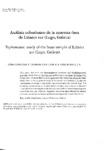Mostrar o rexistro simple do ítem
Análisis tafonómico de la muestra ósea de Liñares sur (Lugo, Galicia)
| dc.contributor.author | López González, F. | |
| dc.contributor.author | Grandal-d'Anglade, Aurora | |
| dc.contributor.author | Vidal Romaní, Juan Ramón | |
| dc.date.accessioned | 2010-01-22T13:26:19Z | |
| dc.date.available | 2010-01-22T13:26:19Z | |
| dc.date.issued | 1997 | |
| dc.identifier.citation | Cadernos do Laboratorio Xeolóxico de Laxe, 1997, 22: 67-80 ISSN: 0213-4497 | es_ES |
| dc.identifier.issn | 0213-4497 | |
| dc.identifier.uri | http://hdl.handle.net/2183/6279 | |
| dc.description.abstract | [Abstract] This paper deal with the biostratinomic processes and fossildiagenetic processes which affected the bone rest of Pleistocene age from the Liñares Sur carstic cave. AH show that the active processes was creepy remaining the fossil bones close ro the original situation of the animal and showing a distinctive intervention of rodents (rooth marks) inmediately after the death of those. The burial was produced by solifiuxion which includes bone remains in between clays and shales resulting from the decalcification ofthe hybrid limesrones that constitutes the cave. After this happened the bones were affected by edaphic processes becoming encrusted, patinated and tinged by Fe and Mn oxides. | |
| dc.language.iso | spa | es_ES |
| dc.publisher | Universidade da Coruña | es_ES |
| dc.subject | Taphonomy | es_ES |
| dc.subject | Upper Pleistocene | es_ES |
| dc.subject | Galicia | es_ES |
| dc.title | Análisis tafonómico de la muestra ósea de Liñares sur (Lugo, Galicia) | es_ES |
| dc.title.alternative | Taphonomic study of the bone sample of Liñares sur (Lugo, Galicia) | |
| dc.type | info:eu-repo/semantics/article | es_ES |
| dc.rights.access | info:eu-repo/semantics/openAccess |






